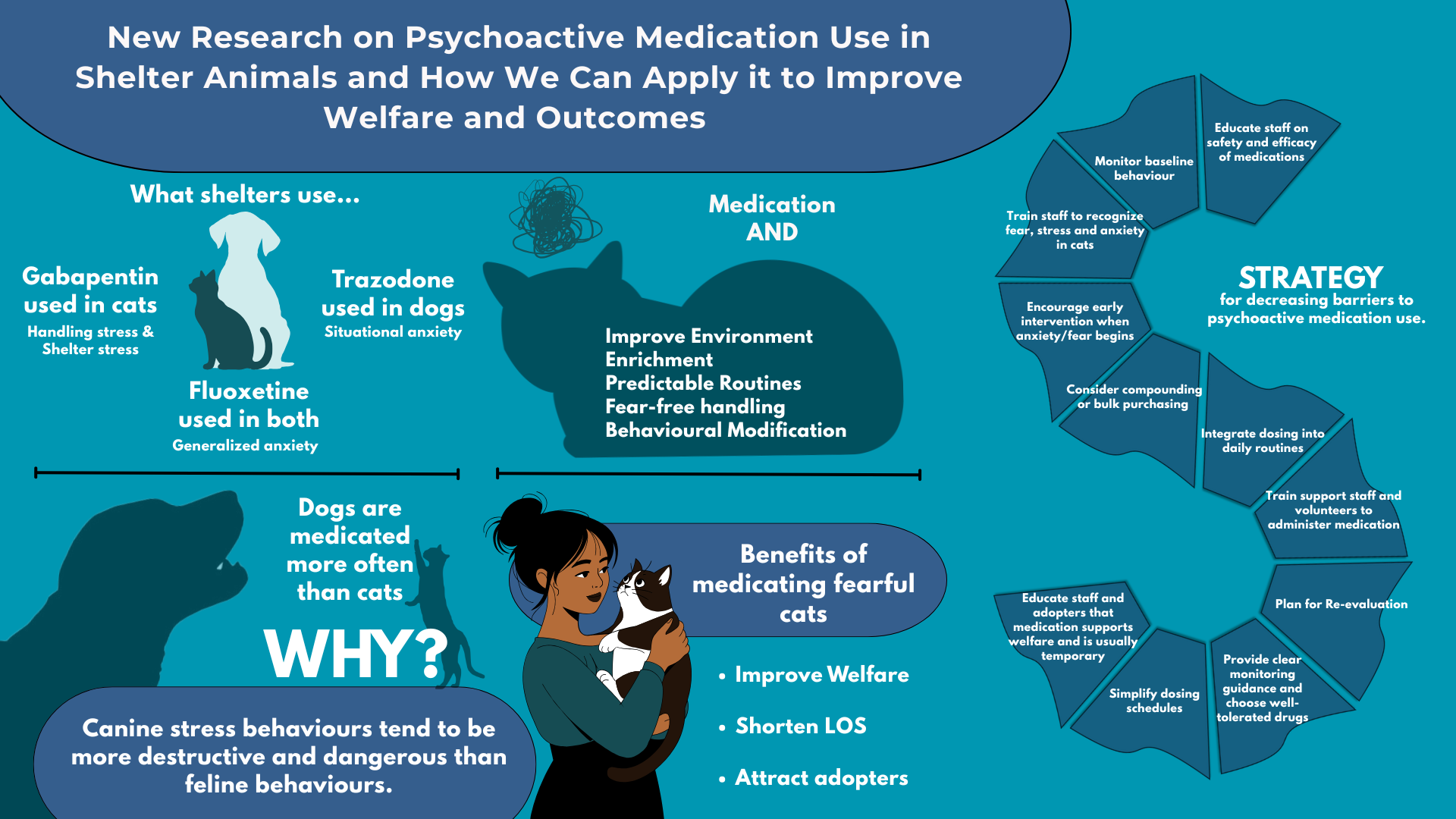
Written by Dr. Hannah Weitzenfeld, DVM
Anyone working in shelter medicine knows the pattern; anxious, fearful animals arrive every day, and our job is to help them cope, recover, and find homes. A recent multi-center study based on a survey by Eagan, Van Haaften, Azadian, and Protopopova (2025), The Use of Psychoactive Medications and Non-Medication Alternatives in North American Animal Shelters and Rescues1, examined how animal welfare organizations are using psychoactive medications and non-medication alternatives for cats and dogs in the USA, Canada, and Mexico. The findings provide a useful snapshot of what’s happening across the field — and where our collective practices still vary widely.
Which Medications Are Most Commonly Used
The study confirmed that a small group of medications — gabapentin, trazodone, and fluoxetine — are used most often in shelter settings.
- Gabapentin was most common for cats, often used to reduce fear and handling stress.
- Trazodone was most common for dogs, especially for situational anxiety.
- Fluoxetine was frequently used for both species to address generalized anxiety or chronic stress.
Overall, staff reported feeling moderately to highly comfortable using these medications and generally perceived them as effective in reducing fear and anxiety. Non-drug interventions such as pheromones and nutraceuticals also remain common, though confidence in their effectiveness is mixed.
Species differences in Treatment of Fear, Anxiety and Stress
Dogs are prescribed anxiety medications more often than cats, likely due to longer shelter stays and higher non-live outcomes, especially for larger breeds2. Prolonged shelter stress can lead to aggression, fear-based reactivity, or destructive behavior, creating safety risks that make medication use more common in dogs. Cats, who often hide or freeze, are less likely to be medicated—a difference that seems to be driven more by cultural norms than medical need.
Why give fearful cats anxiety medication?
- Reducing fear, anxiety and stress in shelter cats directly improves their welfare and quality of life in the shelter.
- Research shows that active cats that interact with humans have a shorter shelter length of stay3
- Evidence for early or prophylactic use: some high-stress cats, like those from hoarding situations, can benefit from early or targeted anxiety treatment, improving both their welfare and adoptability4.
Study Findings & What Shelter Veterinarians Can Do
The shelter environment was seen as the main cause of anxiety. To overcome this, shelters can pair treatment with overall environmental improvements, enrichment and predictable routines as well as providing fear-free and low-stress handling training to animal care staff and volunteers. Fear Free shelters training is free for shelter staff and volunteers.5
Barriers to Psychoactive Medication Use
| Perceptions about safety, efficacy and administration | Work closely with animal care and behavior staff and volunteers, educating them about behavioral medications, including safety, effectiveness, administration options and fear-free handling. Ensure animals have regular behavior and welfare evaluation as part of shelter monitoring to provide a baseline to monitor behavioral trends, Ie. add behavioural indicators to animals’ daily monitoring forms. Create regular re-evaluation plans for animals receiving treatment to monitor efficacy, side effects and outcomes. Educate staff about the importance of recognizing and treating fear, anxiety and stress in cats. |
| Cost | Prioritize low-cost, evidence-based options and discuss compounding or bulk purchasing. |
| Time constraints | Simplify dosing schedules, using medications that require once or twice daily dosing where possible. Integrate medication into daily routines ie. Medicating at/just before feeding times when appropriate. Train support staff and volunteers to administer medication, reducing burden on medical staff. |
| Side effect concerns | Provide clear monitoring guidance and choose well-tolerated drugs. |
| Adoptability worries | Educate teams and adopters that medication supports welfare and is usually temporary. Provide condition and medication information and take-home instructions for adopters. |
| Reactive rather than proactive use | Encourage early intervention when fear or anxiety emerges. |
The Takeaway
Medication is not a shortcut or a replacement for good husbandry, enrichment, and handling — it’s a humane, evidence-based tool that can reduce suffering and support learning when used intentionally and monitored carefully. As shelters face longer dog stays, more complex behavior cases, and persistent feline intake, embracing an individualized, evidence-based approach to behavioral health — including appropriate use of psychoactive medications — helps ensure that every animal gets the best chance at a calm, safe, and short shelter stay, and a successful outcome.
References
1. Eagan, B. H., van Haaften, K., Azadian, A., & Protopopova, A. 2025. The use of psychoactive medications and non-medication alternatives for cats and dogs in North American animal shelters and rescues. Journal of Shelter Medicine & Community Animal Health, 4(1), 115. https://doi.org/10.56771/jsmcah.v4.115
2. Brown, W. P., & Stephan, V. L. (2020). The influence of degree of socialization and age on length of stay of shelter cats. Journal of Applied Animal Welfare Science, 24(3), 238–245. https://doi.org/10.1080/10888705.2020.1733574
3. Eagan B. H., van Haaften K, Protopopova A. 2023. Daily Gabapentin Improved Behavior Modification Progress and Decreased Stress in Shelter Cats from Hoarding Environments in a Double-Blind Randomized Placebo-Controlled Clinical Trial. J Am Vet Med Assoc. 261(9):1305–1315. doi: 10.2460/javma.23.01.0044.
4. Shelter Animals Count. 2024 End of Year Report. Shelter Animals Count. Accessed October 8 2025. https://www.shelteranimalscount.org/explore-the-data/statistics-2024
5. Fear Free, LLC. (n.d.). Fear Free Shelter Program | Learn how to reduce stress in shelter pets. Fear Free Shelters. Retrieved October 9, 2025, from https://fearfreeshelters.com/
